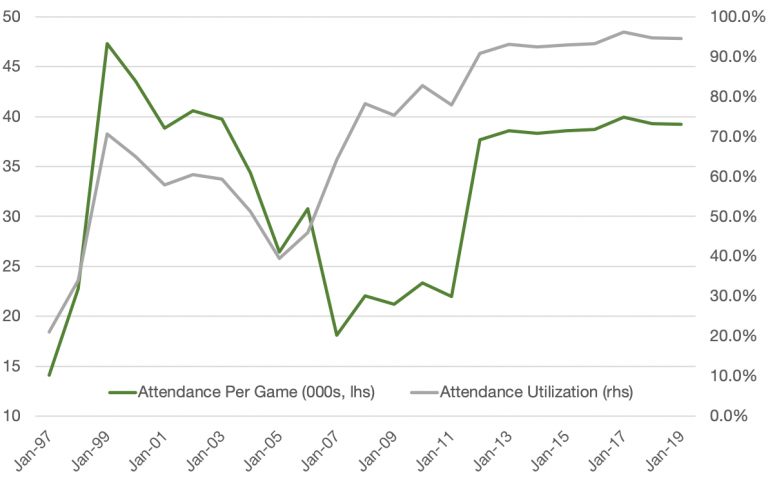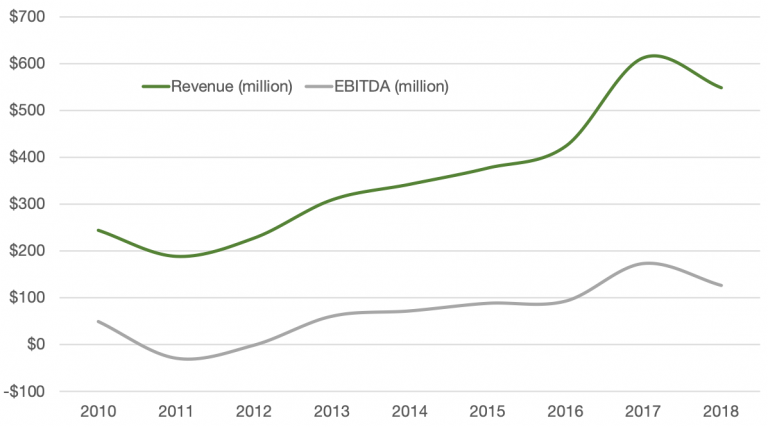GreenWood’s fascination and respect for the Agnelli family, and the respective companies under its leadership, is well documented. We are Exor shareholders, which in turn, means we own an indirect stake in the legendary football club, Juventus (JUVE). To the investment community, the names Fiat, Ferrari, and Sergio Marchionne are most recognizable; however, to a global audience it is the passion for I Bianconeri (the Black-and-Whites) that is more evident. The 2017 Champions League final between Juventus and Real Madrid attracted over 350 million viewers worldwide.
Q2 hedge fund letters, conference, scoops etc

Perhaps this discrepancy within the investment community is due to the fact that running a football club is neither easy, nor historically very profitable. However, as detailed in The Club, discussing the English Premier League (EPL), football clubs can be value-creating machines if run in the proper manner. In the short span of 25 years (the EPL was formed in 1992), the aggregate value of the twenty clubs that make up the league has increased from $100 million to over $15 billion. Through a combination of improving the quality of the football, improving the stadium experience, and expanding distribution and partnership agreements, the global business of football (soccer for those Americans reading) is booming.
Today, with a market value of $1.7 billion, Juventus is the 10th most valuable football club in the world. Juventus are winners of 8 straight Serie A titles, 4 straight Italian Cups and have been in the Champions League final in 2 of the last 5 years. Such sustained excellence is rare in club football, and so there may not be a better time in the modern era to be a Juventus fan, or a shareholder of the club.
While Juventus is a global brand with 29.6 million Instagram followers and sponsorship deals around the world, the Agnellis have never forgotten the club’s roots. Juventus F.C. was formed in 1897 by pupils from the Massimo D’Azeglio Lyceum school in Torino. The longtime association between Juventus and the Agnellis was cemented in 1923 when Edoardo Agnelli gained control of the club and built a new stadium.
To forge close ties with the Torinesi, an annual pre-season intrasquad match has taken place on the Agnelli estate, 40km outside of Torino, in Villar Perosa since 1955. This match, which will again be played in just a few weeks, showcases the squad with no security barriers on the field, leaving an intimate atmosphere between the local fans and their hometown club. After the game, players interact with spectators, give out uniforms, sign autographs and take pictures with kids who will undoubtedly become lifelong fans. This connection with its supporters breeds loyalty and forges connections that could not be made by simply being born in Torino.
After having invested in Fiat since 2011, and Exor since 2013, this tight-knit culture has permeated how Greenwood has tried to build a truly different approach to an industry that is filled with ego and capital, similar to football. As a signal of faith and openness, we’ve made the commitment to not lock-up our investors’ capital. We believe having a transparent organization with timely portfolio updates allows us to make the best decisions possible during difficult periods. This couldn’t come at a better time given the peak irrationality we are seeing in markets and specifically in certain of our investments. We do feel we have fantastic relationships with our partners, and they have rewarded us with an unrivaled retention rate. Steven and I look forward to announcing important new innovations and partnerships to deepen these intimate relationships at our upcoming investor day in early September.
While it’s pleasant to highlight the value and moat of Juventus today, it wasn’t always a feel-good story. In order to appreciate the re-established glory JUVE finds itself enjoying today, we must take a journey back to one of the darkest periods in Juventus’ history. As is too often the case in sports, passion and greed can overtake the love of the game. And this came to a head at the end of the 2005/2006 season when the club, along with a few Italian rivals, was charged with match fixing. Known as the Calciopoli match fixing scandal, this event placed a large black stain on the history of Juventus and Italian football. Juventus, and in particular its Managing Director, Luciano Moggi, was charged with attempting to select certain referees for its home games that were more partial to Juventus. The league was harsh with its penalty, and as a result of sanctions placed on the club, it was demoted to Serie B (Italy’s 2nd division), stripped of its previous two league titles, deducted nine points the following season, and removed from its place in the Champions League. It is difficult to overstate how significant a blow this was to the club; however, Juventus fought back and found a way to regain its former glory.
While there were certain star players who left, including Zlatan Ibrahimovic, Fabian Cannavaro, and Patrick Vieira, there were a host of extremely talented and dedicated ones who believed in the process and the Juventus way – Gianluigi Buffon, Alessandro Del Piero, and Pavel Nedved. With these three players as the backbone, the Zebras (Juventus has a black and white striped jersey) won Serie B during the 2007 campaign earning itself a promotion back into Serie A. Even after moving back to Serie A for the 2007/2008 season, the team struggled to regain its place atop Serie A. Following a seventh place finish in 2009/2010, missing out on Champions League football, and having not ‘officially’ won Serie A since 2003, a change at the top was required.
It was the appointment of Andrea Agnelli as Chairman in May 2010 that ushered in a stable foundation and great vision for the club. Although many already saw an Agnelli as the “rightful” leader due to the family’s longstanding ownership of the club, having him in the forefront brought much needed vision and stability to the club. Nine years on from his appointment, Juventus is stronger than ever. Had investors purchased equity in JUVE when Mr. Agnelli stepped into his leadership role, shareholders would have compounded capital at almost 18%. While it’s still a small weighting in the Exor portfolio, we were able to benefit from the alpha Andrea has generated.
How was Mr. Agnelli and Juventus able to pull off this turnaround after having its reputation tarnished, its revenue reduced, its profits collapse and its players exit all while building a new stadium? They closed ranks by hiring former club captain, Antonio Conte, as manager, became a lean and hungry machine, and turned the conventional transfer market thinking on its head.
We are currently in the transfer window. It’s a period of time during the Summer months and a few short weeks in January, where clubs throw billions of dollars around for the right to buy players from other clubs. We note, it’s not an actual purchase, it’s just the right to sign a player. Call it an option. This practice is very different than American sports where we often hear of “trades” or “free agency.” In global football, a club must pay another club for the right to sign him, and this fee is typically paid prior to any agreement on wages for the player. Until 2011, JUVE was in many ways no different than other clubs by splashing around significant cash for big names to have an instant impact. However, for Juventus, in the years post-Calciopoli with less revenues to spend than it otherwise would have had, it started to prowl around the market for what we might consider, contrarian value. 2011 was the start of a new strategy that’s helped revitalize the JUVE brand.
The signing of Andrea Pirlo from cross-town rivals, AC Milan, in 2011 for ‘nothing’ was controversial. The conventional wisdom was that Pirlo was past his prime at 31 years old and thus no club would offer him anything beyond a 1-year deal; however, JUVE extended a 3-year contract to the World Cup winning legend. This was the the beginning of a new strategy to embrace the Bosman “Free” transfer. While historically done in order to fill the need of a one-off position for a short period of time, Juventus took a new approach by using it to source players either coming off long, expensive contracts, or in the later stages of their career (i.e. Buffett’s cigar butts).
Since 2012, JUVE has gone on to secure many other high profile “free” transfers with established winners such as Dani Alves and Sami Khediera, but then also find those that have significant upside potential like Adrien Rabiot, Kingsley Coman, and Emre Can. By far, the most impactful and value-accretive “free” transfer was Paul Pogba. In 2012, Juventus signed 19 year-old Pogba from Manchester United, and only four seasons later (and after winning four league titles) sold him back to Manchester United for a world-record fee of $116 million.
In total, since 2011, the top 10 free transfer signings by Juventus have created $204m of value (i.e. market value of the players at time of signing) and over $135 million of cash from transfer sales proceeds. Yes, Pogba was an outlier, but JUVE has utilized the free transfer market better than any other club over the past decade.
Why? JUVE’s culture and the dogged pursuit of any player it deems worthy of joining the club. The transfer market is known for deception and lukewarm talks. Not with Juventus. The team goes into negotiations with the surgical precision of a SEAL strike team knowing all the possible outcomes ahead of time. The strategy shift and regained momentum generated by Andrea Agnelli has compounded the team’s ability to recruit better players and achieve better outcomes on the field. This compounded momentum has created a winning culture leading to a positive reinforcement effect for potential signings to want to join a winning team.
Clearly this strategy is not isolated to Juventus, but the club has proven to be better at it than most. Possibly because it has one of the great value-creating families at the helm, or possibly because its organizational goals are aligned. Similar to the strategic and reporting histories of Exor’s other companies, radical humility and honesty are inherent to the process of winning.
The ability to create this culture and winning environment was strengthened by the completion of its own stadium in 2011. From 1990 through the 2006 season, Juventus played matches at the Stadio Delle Alpi (built for the 1990 World Cup), a 67,000 seat arena, too large even for the best attended club in Italy. The elegant new Juventus Stadium (now named Allianz Stadium) was opened in September 2011 on the site of the old Stadio Delle Alpi. Built and owned by Juventus for around €150 million, it also included local partners who contributed €90 million for a shopping center to help revitalize the area.
Beyond increased revenue from attendance (JUVE has sold out all available season ticket passes since 2013) and sponsorship deals, owning a stadium presents opportunities, and control of, content creation. Angelli was able to create the Juventus Museum and the Juventus College, which is a high school dedicated to the kids playing in JUVE’s youth system, a first in Italy. A further step was taken in June 2013 with the allocation of 176,000 square meters next to the Juventus Stadium to create a new Training and Media Center and house the new registered office of the company. All of these transformational changes were recently profiled by a Netflix docu-series called First Team, in early 2018.
Exhibit 1: Juventus Attendance & Stadium Utilization
Source: transfermarkt.com
As Mr. Agnelli’s vision was bearing fruit with the club winning domestic trophies, one can imagine the calls to return profits to shareholders from the Pogba sale in 2016 would have been extreme at many other clubs not run by the Agnellis. Yet Exor doesn’t make decisions in order to boost the short-term performance of its holdings, it makes decisions to maximize the long-term value. Unlike what most public companies are doing today, JUVE chose to reinvest those proceeds to further enhance the quality of the squad. By lavishly spending on Gonzalo Higuain and Miralem Pjanić, who happened to be the best players on rival teams, JUVE effectively consolidated its power in Serie A and contending for titles in the Champions League. These moves widened the club’s moat considerably and demonstrated the benefits of having an owner-operator, with skin in the game, at the helm.
Which leads us to the biggest of all transfer payments: Ronaldo.
Some may toss back, “Yes, how could Ronaldo and his $119m transfer fee be ‘value’?” In your author’s eyes, he was worth every penny. Not just because of his goal-scoring prowess (28 goals in all competitions last season), but his signing was the culmination of the Juventus re-branding strategy that took it from a “stepping-stone” club, to a perennial powerhouse. The kind of powerhouse where foreign players seek out the opportunity to play there. Ronaldo is a 5-time Ballon d’Or winner, who brings unrivaled dedication to his craft. His former manager, Sir Alex Ferguson, once said of Ronaldo, “He used to completely exhaust himself, and still does. He just wanted to be the best in the world.” That kind of drive to win is infectious and it’s leading young players, who idolize Ronaldo, to join him – as evidenced by JUVE’s recent signing of star Dutch defender, Matthijs de Ligt.
Let us not forget this is a business, and Ronaldo prints money. Before the ink dried on the contract, the Ronaldo effect took Juventus, and Italy, by storm. His name generated over $60 million in jersey sales in one day – that is the best global branding a club can ask for. JUVE’s Twitter account showed a 10% increase in followers on the day he was signed. Then ESPN acquired the U.S. Serie A TV rights at a massive step-change in the fee ($55 million per year, versus $28 million previously) only one month later. And to no one’s surprise, the first game aired on August 18th showcasing Ronaldo in his new black and white jersey. Your author duly signed up for ESPN+ exclusively to live stream I Bianconeri. The acquisition led to a nice bump in GreenWood’s performance, and most importantly, Ronaldo helped his team win another Serie A title.
The compounding effect of Agnelli reinvesting in his business has produced truly staggering financial results since he took on the leadership role. Revenues under Mr. Agnelli’s watch have gone from $188.9 million in fiscal year 2011 to $549.9 million in 2018. Notice how EBITDA actually worsened in the first years after Agnelli took the helm. Growth required investment. Investors today forget that value creation requires capital and expense. It doesn’t come for free.
Exhibit 2: Revenue & EBITDA of Juventus
Source: CapIQ
To bring it full circle, those three superstars who stayed at Juventus during the Calciopoli scandal were rewarded and will never be forgotten. While Pavel Nedved’s playing career ended after the 2009 season, he went on to be nominated by Exor to join the Board of Directors in 2010 and currently sits as the Vice Chairman of Juventus. Buffon, at the ripe age of 41, is a player/advisor to the club and has made the second most appearances ever for the club, second only to…Alessandro Del Piero. These players are living legends in the minds of all Juventus supporters because they stayed with the club during the most trying of periods and continued to win trophies.
We must remind ourselves that there will be periods of difficulty, and under-performance, but we will always come out stronger on the other side if we use the adversity to our advantage. We are doing so today, and we look forward to detailing such initiatives in our quarterly letter in the near future.
Article by Chris Torino, GreenWood Investors


